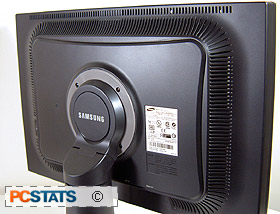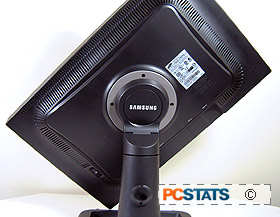Using the
SyncMaster 243T was a pleasure in all aspects (pun intended). While we were a
little dubious of the claimed 170 degree (85 degree horizontal) viewing radius,
the display was clearly legible from some distance away and at a variety of odd
angles.  Colours did start to lose saturation
after about 45 degrees though. Still, several people could crowd in
front of this monitor without anyone experiencing the dreaded 'LCD fadeout' effect.
Colours did start to lose saturation
after about 45 degrees though. Still, several people could crowd in
front of this monitor without anyone experiencing the dreaded 'LCD fadeout' effect.
Using the digital DVI input, the picture is
incredibly crisp and sharp and colours seem to leap off the screen.
The included Pivot
Pro utility offers good functionality for those who want to pivot the
SyncMaster 243T's screen to portrait mode. It integrates with the display properties of
your Windows desktop and allows automatic resolution changes along with screen
orientation changes. The portrait mode resolution does need to be set manually
the first time you change it though.
Viewing
this display in portrait mode was fantastic when it came to surfing the web or
editing documents.  The amount of screen real-estate allocated to each web page
when viewing in this aspect almost gave us vertigo; the screen seemed
to just keep going down and down...
The amount of screen real-estate allocated to each web page
when viewing in this aspect almost gave us vertigo; the screen seemed
to just keep going down and down...
Image
characteristics were excellent also. The 500:1 contrast
ratio insured that black areas of the screen were really black, and
colours were bright and realistic when viewed within a 45 degree arc
of the centre of the screen. Luminance is pegged at 300cd/m2.
When it
comes to gaming, a huge LCD screen like the
SyncMaster 243T might seem like a natural object of desire, but it ain't necessarily
so. Like most LCD screens, the SyncMaster 243T sports a 25ms pixel
response time which is fine for most graphical applications, but can lead to
perceptible visual strangeness in fast moving games. We tested this display
with Half Life 2, and while the game looked utterly fantastic, it
suffered from jerkiness and hazy graphics when the image was moving fast
(which was most of the time). Don't get us wrong, it was still very
playable, but if you are a hardcore gamer you can buy much better displays for
gaming with $2700!
 |
|
PCStats LCD Display Evaluation Criteria |
|
|
PCstats evaluates the screen characteristics of
LCD monitors with the help of a program
called Monitor Test. This software application displays a range of
primary colours and special monitor test patterns which enable an
observer to diagnose just about any visual problem, or defect an LCD
display may be hiding.
The software consists of about eleven
tests which can be run in steps, as adjustments are made through the
OSD to optimize the monitor. Though some tests are primarily
intended for CRT monitors, Monitor Test is still a good tool for
evaluating common visual problems which can indicate of the quality
of LCD panel used, and its limitations.
Two critical items not covered by
Monitor Test are broken LCD pixels, and
pixel response times, which if too slow, can cause
blurring or ghosting of fast moving objects on the screen.
Broken Pixels: What we class as a
'broken pixel' can fall under any one of the following
circumstances: pixels that are always on (any colour), pixels that
are always off, pixels which are unable to display a primary colour
or shade (red, green, blue), or pixels which only display white or
black. While many manufacturers may consider a few broken pixels
acceptable, we believe the high cost of LCD displays should
translate into a clear and unblemished image that does not include a
single conspicuous broken pixel.
Pixel Response Time: Pixel
Response Times are measured in milliseconds, and account for the
rise and fall state, or the total time it takes for a pixel to
respond, and return back to its original state. We look for any
streaking associated with moving a full page of text up and down
very quickly. Displays with slow pixel response times tend to show
some degree of image streaking, or text discoloration in this simple
but effective test. Response times can also cause ghosting in games
where there are many fast moving objects. A response time of 25ms or
less is generally considered desirable.
All of our test parameters are user reproducible, so
you can try them yourself when evaluating displays.
:)
|
| Test Specs: |
|
Videocard:
Radeon9600XT
Operating
System:
Windows 2000
Display Settings:
Interface:
Analog/DVI
Resolution:
1920x1200
Frequency:
60Hz
Colour:
32
bit
| | |
